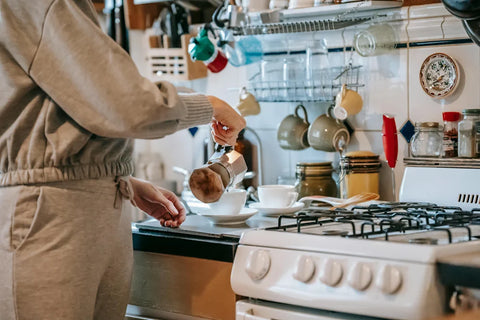How to Taste Coffee Like A Pro?

Can you imagine what it would be like to get up in the morning, go to the kitchen, and notice a fragrance of berries when you grind coffee?
Or taste brown sugar when you first sip your freshly brewed coffee?
Maybe it sounds a bit crazy, but these notes are natural when you buy good coffee; it makes you smile when you taste it.
Here we suggest a very simple method, similar to the one we use to cup coffee, called Brazilian Coffee cupping, to try coffee at home and discover these flavors that you see in specialty coffee tags.

Heads up! We are saying that you will try real coffee, not instant coffee or coffee already ground from the supermarket (sometimes we don't know how long it has been on the shelf).
TO CUP YOUR COFFEE, YOU NEED THE FOLLOWING:
- Freshly roasted coffee beans (that preferably has less than three months of roasted)
- Filtered water, bottled or from your refrigerator/ home filtration system
- A flat or conical grinder, we recommend an affordable start like this one
- A kettle to boil water, cups, and spoons.
- A kitchen scale to know how much water and coffee we are using
And that's it.
We recommend grinding your coffee in a medium grind, like regular sugar, just like you use it for your drip coffee maker.

**HOW TO TASTE YOUR COFFEE**
We use a recipe of 10 grams of coffee and 150ml of hot water at 90C/194F, simple as that.
STEPS [Simple Method]
- Grind the coffee and smell the fragrance by closing your eyes to allow you to perceive more through your nose and leave your mouth open while smelling.
- Pour the hot water and let it infuse for 4 minutes.
- Now, break the crust with a spoon while you smell the aromas and try to identify what it smells like.
- Lastly, we will remove the crust with the spoon, and we will taste the coffee on three occasions:
- At the end of the 4 minutes, it should still be hot, so take note of the flavor, the body, and the acidity.
- Try it again when it is warm, approximately 10 minutes after infusing it, and reevaluate the previous attributes; has it changed? Does it feel sweeter, more bitter, or more acidic?
- Finally, taste the cup completely cold and note how much the profile of that coffee changed at a cold temperature.
Usually, you will find sweet notes; the easiest to detect are brown sugar, caramel, chocolate, and fruit, sweet flavors.
Tip: Mexican coffee has a variety of notes of chocolate, fruit, and nuts.
⚠️If you detect flavors of grass, hay, wood, potato, rubber, carbon, ash, and even mold, the coffee is of low quality or has roast defects, whether raw or burnt.

This exercise helps us to identify the different stages our coffee goes through with temperature changes and, surprisingly, if you find different flavors as it cools.
*As you will notice, the coffee will not be filtered at any time; it stays in the cup with the water, which will taste the different stages of the coffee over time.

But wait, what is the body of a coffee?
It is generally defined as the density of the coffee in your mouth, in other words, how heavy it is; for example, think about the sensation when you drink hot chocolate = heavy or green tea = light. It's often called mouthfeel.
And the acidity?
A good coffee has to have sweetness and acidity, which you feel on the sides of your tongue and makes you salivate. Acidity is one of the most precious attributes of specialty coffees because a plain coffee with no acidity is considered "boring" or not complex at all.
On the other hand, think about the tartness of a blueberry or lemon. By the way, acidity in coffee has nothing to do with heartburn.
We will learn more about the body and acidity in another post.
This method is a VERY SIMPLIFIED way of tasting your specialty coffees, which is a similar but more detailed method of tasting coffees after roasting and evaluating their quality.

In summary, this exercise we propose does not mean that if you prepare your regular coffee, you will not taste the notes of the coffee.
However, it will help you to train your palate and make you more sensitive to discovering a new range of flavours!
Keep reading:
The 10 Best Specialty Coffees in America (2022)
All you need to know about Mexican coffee
Latest Coffee Blog Posts

Our Coffee-Filled Adventure at Coffee Fest Orlando 2025
Coffee Fest Orlando 2025 brought together coffee lovers, roasters, and café owners for an unforge...
Read more →
Is there a sommelier for coffee?
Ever heard of a Q-grader? Often called a coffee sommelier, these certified professionals are the ...
Read more →
Which Coffee Roast Works Best with Your Machine?
The coffee roast you choose can make or break your brew. Learn which roast level pairs best with ...
Read more →